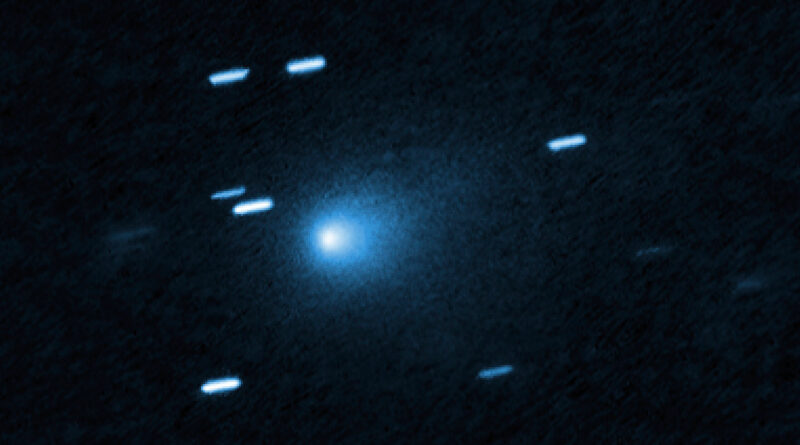Hubble Captures Interstellar Comet 3I/ATLAS in Stunning Detail | 2025 Space Discovery
On July 21, 2025, NASA’s Hubble Space Telescope took the clearest picture ever of a strange comet called 3I/ATLAS. But this isn’t a normal comet—it’s an interstellar comet, which means it came from outside our solar system. It’s only the third time we’ve ever seen something like this.
A Super Fast Space Traveler
This comet is flying through space at a crazy speed—about 130,000 miles per hour! That’s way faster than the comets that live in our own solar system. It’s moving so quickly because it doesn’t orbit the Sun like our planets do. It came from another star system far, far away.
In the new picture, the comet looks like a glowing dot with a hazy cloud around it and a long, dusty tail. It’s beautiful and kind of spooky—like something straight out of a sci-fi movie.

It’s Smaller Than We Thought
Before Hubble took this close-up, scientists weren’t sure how big the comet’s icy center—called the nucleus—really was. Now, they believe it’s pretty small.
It might only be about 1,000 feet (320 meters) across. At most, it could be around 3.5 miles (5.6 kilometers) wide. That’s like the size of a small town or a big mountain. Still, it’s amazing that something so small could travel such a huge distance across space.
A Rare Guest From Another Star
So, why is this comet such a big deal?
Because it didn’t come from our Sun or any planet we know. It came from a whole other star system. That makes it a visitor from another world. We’ve only ever seen two other space objects like this before—one in 2017 (called ‘Oumuamua) and another in 2019 (called 2I/Borisov).
These interstellar objects are like time capsules. They were formed around other stars billions of years ago, and now we get a chance to study one up close. It’s like finding a lost letter from a distant galaxy.
More Than Just Hubble
Hubble isn’t the only telescope watching this comet. Other space telescopes—like the James Webb Space Telescope and TESS—are also studying it. Big ground-based telescopes on Earth are joining in too.
Together, scientists are trying to learn:
-
What the comet is made of
-
How it sheds dust and gas
-
How it compares to comets in our own solar system
This teamwork will help scientists understand how other solar systems form and what kinds of materials they’re made of.
Should We Worry?
Not at all! The comet is not going to hit Earth. It’s just passing through. But it’s giving scientists a rare and amazing chance to study something from a completely different part of the galaxy.
The more we learn about comets like 3I/ATLAS, the better we understand the story of space, planets, and maybe even how life started.
View this post on Instagram
Quick Summary
-
In July 2025, Hubble took the best-ever photo of an interstellar comet called 3I/ATLAS.
-
This comet is moving at 130,000 miles per hour—much faster than any local comet.
-
It’s much smaller than scientists first thought—maybe just 1,000 feet wide.
-
It came from another star system, making it one of the rarest objects we’ve ever seen.
-
A team of telescopes is studying it to learn about how planets and solar systems are born.
-
It’s not dangerous, just a very cool visitor from deep space.
Why This Matters
This comet might look like just a small speck of ice and dust, but it’s carrying clues from another world. It could tell us what other solar systems are made of and maybe even help us understand how life could start elsewhere in the universe.
Moments like this remind us how big space really is—and how many surprises are still out there, waiting to be found.
So, next time you look up at the stars, remember: something from another star might be sailing through our skies, right now.


Pingback: Asteroid Impact Probability: Shocking 1 in 155 Odds of a Strike in Your Lifetime,
Pingback: Universe Vastness: 10 Astonishing Facts That Will Change How You See Space
Pingback: Hurricane Cluster Hotspots: 5 Alarming Facts About the North Atlantic
Pingback: See 6 Planets Align in the Night Sky This August – Don’t Miss It
Pingback: NASA Rovers Getting Stuck: 3 Surprising Reasons UW Engineers Found
Pingback: Is Interstellar Object 3I/ATLAS a Alien Probe? The Astonishing Possibility